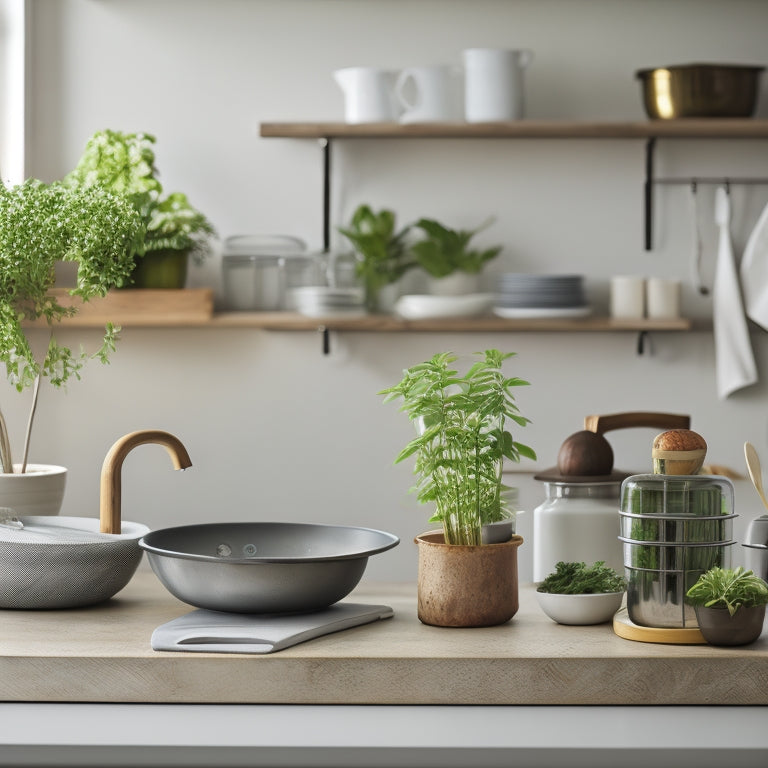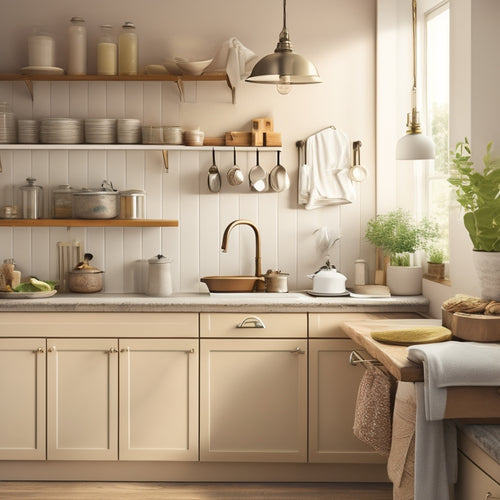
7 Essential Tips for a Clutter-Free Kitchen
Share
To achieve a clutter-free kitchen, start by defining what that means to you and setting specific goals. Next, purge unwanted items like expired food and broken gadgets, and assign a home for everything to maintain organization. Create a zone for cooking with ample countertop space and essential appliances within reach. Optimize your storage spaces, establishing a cleaning routine and designating weekly tasks. Finally, maintain your new habits by tracking progress and finding an accountability partner. By following these 7 essential tips, you'll be well on your way to a peaceful and functional kitchen - and the best part is, there's more to discover.
Key Takeaways
• Define a clutter-free kitchen by setting specific goals and priorities to maintain focus on what needs to be accomplished.
• Purge unwanted items by checking expiration dates, removing broken or duplicate items, and discarding unused gadgets and utensils.
• Assign a home for each item by categorizing, labeling, and designating specific areas to promote organization and accessibility.
• Create a cooking zone by positioning essential appliances, ensuring ample countertop space, and designing for ergonomics and comfort.
• Establish a daily cleaning routine by wiping down countertops, cleaning dishes, and tidying up to maintain a clutter-free environment.
Start With a Clear Goal
Start With a Clear Goal
Define what a clutter-free kitchen means to you, and identify the specific benefits you want to achieve, such as more free time, reduced stress, or improved cooking efficiency. This clarity will serve as your motivation to create a kitchen that works for you, not against you.
To get started, set priorities on what you want to accomplish. Do you want to free up counter space, optimize your storage, or create a more peaceful cooking environment? Whatever your goals, write them down and post them somewhere visible to remind yourself of what you're working towards.
As you begin your journey to a clutter-free kitchen, stay focused on your objectives. Don't get sidetracked by organizing every single item; instead, tackle one area at a time, and confirm each task aligns with your overall vision.
Purge Unwanted Kitchen Items
Get ready to liberate your kitchen from the burden of unnecessary items by tackling the overwhelming task of purging unwanted kitchen items that are taking up valuable space and collecting dust.
To get started, go through your kitchen and identify items that are no longer needed, broken, or haven't been used in a while. Be ruthless – if you haven't used it in the past year, it's probably safe to get rid of it.
Here are some areas to focus on:
-
Expired or unused food: Check your pantry and fridge for expired or spoiled food. Toss anything that's no longer good.
-
Broken or duplicate items: Get rid of broken appliances, utensils, or gadgets that you'll never fix. If you have multiple items that serve the same purpose, keep only your favorite and ditch the rest.
-
Unused cooking gadgets: Be honest with yourself – if you haven't used that fancy cooking gadget in months, it's probably taking up valuable space.
- Utensils without a purpose: Organize your utensils and get rid of any that don't have a clear purpose or are no longer useful.
Assign a Home for Everything
Now that you've purged your kitchen of unwanted items, it's time to create a system where everything has a designated spot, making it easy to find what you need when you need it. This means assigning a home for each item, so it's always in the same place.
Start by categorizing items into groups, such as baking supplies, cooking utensils, and dinnerware. Then, designate a specific area or container for each group.
Label containers and shelves clearly, so you can quickly identify what's inside. Use drawer dividers to separate items like utensils, pots, and pans, keeping them organized and preventing clutter from building up again.
Consider the frequency of use when assigning a home for each item. Store frequently used items in easy-to-reach locations, while less frequently used items can be stored in harder-to-reach areas or on higher shelves.
Create a Zone for Cooking
By designating a specific area for cooking, you'll create an efficient workspace that streamlines meal prep and reduces clutter. This area should be strategically located in your kitchen to maximize cooking efficiency and organization.
Here are some key considerations to keep in mind:
-
Positioning: Place your cooking area near a heat source, such as a stove or oven, to minimize walking distances and optimize workflow.
-
Countertop space: Make sure you have ample countertop space for food preparation, cooking, and plating. A minimum of 24 inches of linear space is recommended.
-
Appliance placement: Position essential appliances, such as a stand mixer or slow cooker, within easy reach to streamline meal prep.
- Ergonomics: Design your cooking area with ergonomics in mind, keeping frequently used items at comfortable heights to reduce strain and fatigue.
Optimize Your Storage Spaces
You can maximize your kitchen's storage capacity by assigning a home for every item, ensuring that everything has a designated place to minimize clutter and make meal prep more efficient. This means utilizing every available space, including the often-wasted areas like the back of cabinet doors and the interior of drawers. Consider installing drawer dividers to separate utensils, cookware, and linens, making them easy to access and preventing a jumbled mess.
Don't forget to look up – vertical shelves can be a game-changer in small kitchens. By installing shelves that reach the ceiling, you can store infrequently used items like special occasion dishes, cookbooks, or baking supplies, freeing up valuable counter and cabinet space. Additionally, consider using wall-mounted racks for pots, pans, and utensils, keeping them organized and within easy reach.
Establish a Cleaning Routine
With your kitchen's storage spaces optimized, it's time to focus on maintaining a clutter-free environment by implementing a consistent cleaning routine that prevents messes from building up in the first place. By establishing a cleaning routine, you'll be able to keep your kitchen organized and tidy, saving you time and energy in the long run.
To get started, incorporate the following tasks into your daily schedule:
-
Wipe down countertops after every meal to prevent crumbs and spills from building up.
-
Clean as you go, washing dishes immediately after use and putting away utensils and appliances.
-
Spend 10 minutes each day tidying up the kitchen, putting away items that are out of place.
- Designate a weekly task, such as cleaning the refrigerator or oven, to tackle on the same day each week.
Maintain Your New Habits
Developing a consistent cleaning routine is only half the battle - the key to a clutter-free kitchen lies in sticking to your new habits. To maintain your progress, you need to create a system that works for you.
| Strategy | Description | Benefits |
|---|---|---|
| Reward System | Set small rewards for yourself when you complete tasks | Motivates you to stay on track |
| Tracking Progress | Keep a journal or use an app to track your cleaning progress | Helps you identify areas for improvement |
| Accountability Partner | Find someone to hold you accountable and schedule regular check-ins | Provides an added motivation to stay consistent |
Frequently Asked Questions
How Do I Handle Kitchen Clutter That's Sentimental or Hard to Part With?
When decluttering sentimental items, you're not getting rid of the memory, just the physical object. Acknowledge your emotional attachment, take a photo, and let it go - freeing up space for better organization and a clearer mind.
What if I Live With Others Who Don't Share My Decluttering Goals?
Did you know 64% of people feel anxious about clutter? You're not alone! When living with others who don't share your decluttering goals, you'll need to communicate boundaries, compromise with roommates, set shared goals, and create designated spaces to maintain your clutter-free oasis.
Can a Clutter-Free Kitchen Be Achieved on a Limited Budget?
You can achieve a clutter-free kitchen on a limited budget by exploring budget-friendly storage solutions, such as repurposing containers or DIY shelves, and implementing creative organization hacks, like using adhesive hooks or over-the-door racks.
How Often Should I Reassess My Kitchen's Organization System?
You should reassess your kitchen's organization system regularly, ideally every 3-6 months, to maintain efficient storage and practical solutions are still working for you, and utilize helpful resources to refine your system as needed.
What Are Some Eco-Friendly Ways to Dispose of Unwanted Kitchen Items?
You're drowning in a sea of unwanted kitchen items, but fear not! You can breathe easy knowing you have recycling options and composting solutions, plus donation opportunities and upcycling projects to give your trash a second life.
Related Posts
-

5 Best Kitchen Organization Products for Arthritis Relief
You're looking for ways to make meal prep easier on your joints. Arthritis can make kitchen tasks a struggle, but the...
